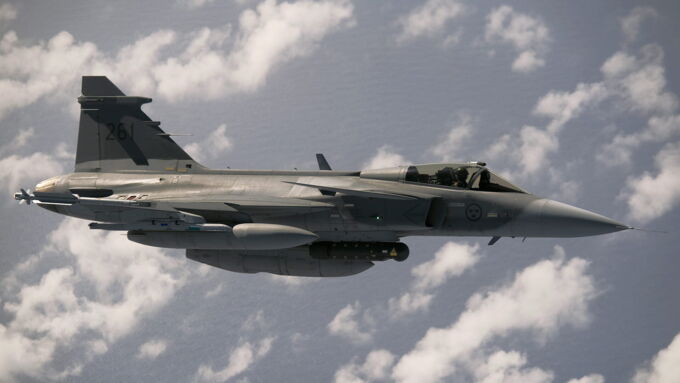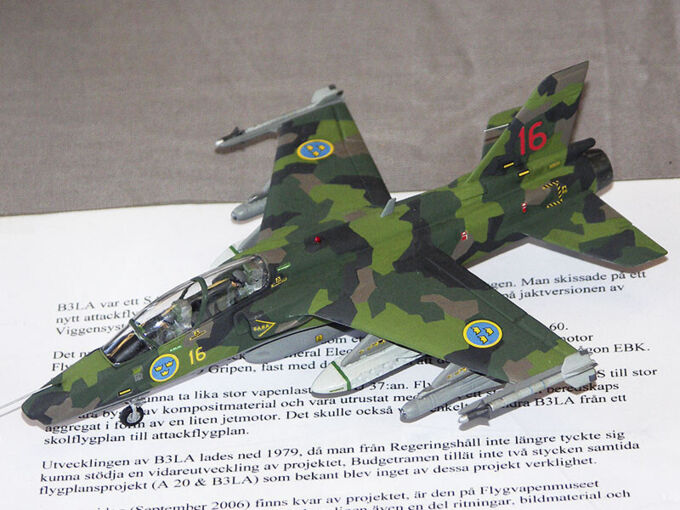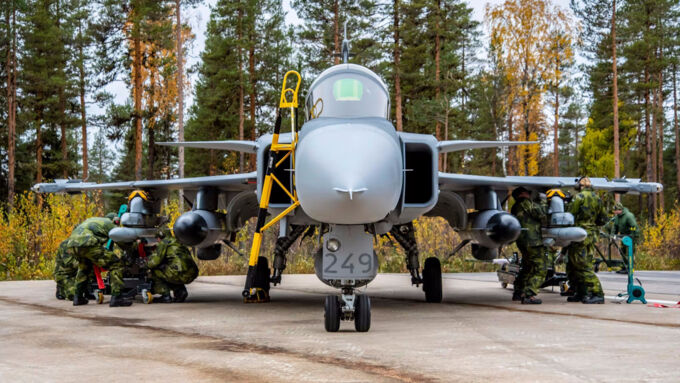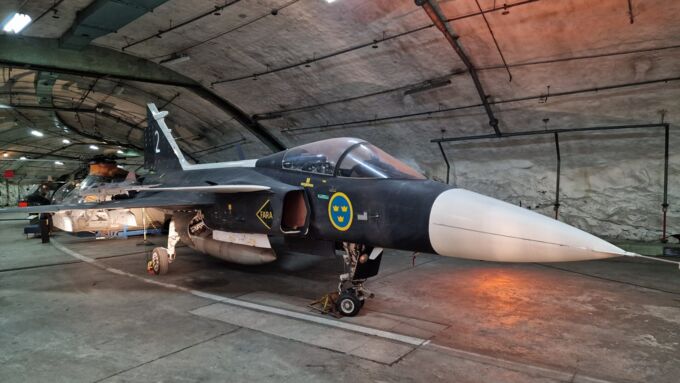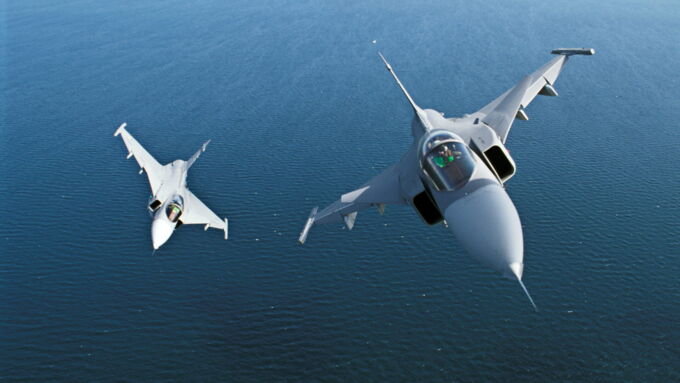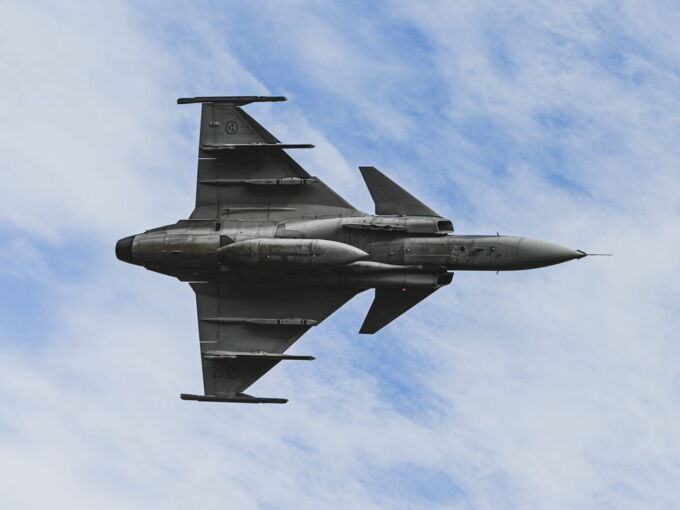The Saab 39 Gripen, often called the JAS 39 Gripen, is a highly capable multirole fighter aircraft renowned for its exceptional maneuverability, advanced avionics, and cost-efficient operation. Since its first flight in 1988 and subsequent introduction into service in 1996, Gripen has become the cornerstone of the Swedish Air Force and has since been adopted by several other nations around the world.
Name
As with all aircraft used by the Swedish Air Force, the designation letters indicate its role. In this case, JAS stands for “Jakt, Attack, Spaning”, translating to “Fighter, Attacker, Reconnaissance”. The order of these letters is significant, as it reflects the aircraft’s primary function. For example, since Gripen was developed primarily as a fighter, it begins with “J”, in contrast to the AJS 37 Viggen, which was primarily designed for attack purposes.
The name Gripen, meaning “The Griffin”, was chosen through a public naming contest in 1982. It follows the tradition established by its predecessors, Draken (“The Dragon”) and Viggen (Åskviggen, “The Thunderstone”), drawing inspiration from mythology.
History
Background
In the mid-1970s, shortly after the Viggen entered service, plans were initiated for a replacement aircraft targeted for the 1990s. Initially, there were two candidates. The first was the A 20 Viggen, a further development of the Saab 37 Viggen, as suggested by its name. The second was the B3LA (or Saab 38), which would have been a collaborative project with the Italian company Aermacchi. Both of these aircraft would primarily be attacker aircraft, and the B3LA, being a two-seat aircraft, would function as a trainer as well.
In 1978, Stig Synnergren, the Swedish Armed Forces' Chief of Defence, proposed three additional options alongside the A 20 and B3LA: developing a multirole JAS aircraft, or importing F/A-18s or F-16s to fulfill the same role. Later that year, Lennart Ljung, the newly appointed Chief of Defence, determined that both the A 20 and B3LA would not be economically viable when considering the costs of developing or importing a multirole fighter.
In 1979, the Swedish Parliament decided to cancel the orders for both the A 20 and B3LA. Following this cancelation, Saab proposed its multirole fighter. In June of 1982, followed by a subsequent vote in April of 1983, the Swedish government approved funding for the development of the JAS 39 Gripen.
Development of Saab 39 Gripen
Following the Swedish government’s decision to fund the JAS 39 Gripen project, the development process began, with key design objectives including a light airframe, advanced avionics, and high operational flexibility. To reduce costs, Gripen was designed with a focus on low maintenance and quick turnarounds. The aircraft was also intended to operate from short and dispersed airfields known as road bases, a feature critical to Sweden’s defense strategy of decentralization.
Like its predecessor, the Saab 37 Viggen, the design concept incorporated a delta-wing configuration with canard foreplanes, which provided excellent maneuverability at both high and low speeds. This layout also allowed for a smaller airframe, which contributed to Gripen’s low radar cross-section.
One of the primary design goals for Gripen was to ensure it could operate from Sweden’s network of the aforementioned road bases, a practice that had already been successfully implemented with the Viggen. These road bases are normal roads that have been widened to facilitate aircraft landings. There are smaller access roads next to these landing strips that lead to concealed aprons in nearby forests, where ground personnel stand ready to refuel and rearm the aircraft, enabling a rapid turnaround time. Sweden’s reliance on road bases allow aircraft to be dispersed across the country, reducing the vulnerability of their airfields to enemy strikes and providing a high degree of operational survivability in a conflict.
A notable feature in the development process was the close cooperation between Saab and Swedish defense authorities, ensuring that Gripen was tailored to meet specific national defense needs. However, Saab also recognized the importance of international cooperation, leading to the involvement of other countries like South Africa and the Czech Republic in the aircraft’s later iterations.
First Test Flights
Gripen’s first flight took place on the 9th of December 1988 at Saab’s manufacturing site in Linköping, Sweden, and it marked the beginning of the aircraft’s comprehensive testing phase. The first Gripen prototype, known as 39-1, was piloted by Håkan Svensson, Saab’s test pilot. This first flight, which lasted for approximately 50 minutes, was primarily focused on basic aerodynamic testing, handling qualities, and verifying the aircraft’s flight control system.
Despite its promising performance, it was also marked by a critical issue involving the fly-by-wire flight control system that would later have serious consequences for the aircraft’s testing phase. During the test flight, the aircraft experienced an issue with its fly-by-wire flight control system that led to a pilot-induced oscillation, a phenomenon that occurs when the pilot unintentionally reinforces the oscillations of the aircraft by overcorrecting inputs.
As noted earlier, this issue was tied to the aircraft’s fly-by-wire system, which was designed to improve handling and reduce pilot workload by electronically controlling the aircraft’s flight surfaces. However, at the time, the system was still in its early stages of development, and fine-tuning was required to ensure a smooth, predictable control response.
The issue with the flight control system was not resolved immediately. In the months following the first test flight, further modifications were made to the fly-by-wire system, including software updates and hardware adjustments to improve its stability. Unfortunately, the problem resurfaced during later flight tests, leading to a crash on the 2nd of February, 1989, during an attempted landing, once again due to pilot-induced oscillation, this time leading to a total loss of control.
Final Stages of Development
The late stages of Saab 39 Gripen’s development were mainly focused on refining the aircraft’s systems, addressing identified issues, and preparing it for operational readiness. By the early 1990s, Saab had made significant progress in resolving issues from the prototype phase and advancing Gripen into a capable, modern multi-role fighter.
One of the critical areas of improvement was the fly-by-wire flight control system, which had caused pilot-induced oscillations during the test flights. After extensive analysis, Saab and its partners, including Ericsson and the American firm Calspan, implemented significant software upgrades to enhance the fly-by-wire system’s stability and responsiveness. These modifications successfully eliminated pilot-induced oscillation, and improved overall handling, making the aircraft safer and more predictable to fly.
As development continued, attention shifted toward integrating Gripen’s advanced avionics, weapons systems, and sensors. The aircraft’s PS-05/A radar, developed in collaboration with Ericsson, was tested extensively to ensure it could meet the demands of air-to-air and air-to-ground missions. This multi-mode radar, based on the British Blue Vixen radar, but adapted for Gripen’s requirements, proved to be a capable system for the aircraft.
The avionics suite, which included a digital cockpit with multi-function displays and a head-up display, underwent rigorous testing to optimize pilot situational awareness and ease of use. Gripen was designed as a true multi-role fighter, requiring seamless integration of air-to-air missiles, precision-guided bombs, and other weapon systems. These capabilities were progressively tested and validated in a series of flight trials.
By the mid-1990s, the Saab 39 Gripen had transitioned into its final pre-production phase. Saab produced a small number of pre-serial production aircraft for operational evaluation by the Swedish Air Force. These aircraft underwent extensive testing under simulated combat conditions, including live weapons firings, high-speed intercepts, and close air support missions. Gripen also demonstrated its ability to operate from the short runways and road bases, as required by the Swedish Air Force.
This extensive testing culminated in Gripen’s official introduction into the Swedish Air Force on the 9th of June, 1996, when Skaraborg Wing (F 7) replaced its AJ 37 Viggen fleet with JAS 39 Gripen.
Armament of JAS 39 Gripen C
Note: This section does not necessarily reflect in-game capabilities at the moment of writing, and varies depending on nation.
List of Supported Armament
IR Missiles:
- A-Darter
- AIM-9 Sidewinder
- AIM-132 ASRAAM
- IRIS-T
- Python 4/5
Radar Missiles:
- AIM-120 AMRAAM
- Derby
- Meteor
- R-Darter
Bombs:
- GBU-39, SDB I
- JDAM/JDAM-ER (GBU-31/-32/-38)
- Lizard II/III
- MK80 Series
- Paveway II (GBU-10/-12/-16/-49)
- Paveway III (GBU-22/-24)
- SPICE
Air-to-Surface Missiles & Standoff Weapons:
- AGM-65 Maverick
- Brimstone
- RBS-15
- AGM-154
- DWS 39
- Taurus KEPD 350
Armament Configuration
| Hardpoint | Wingtip | Outer Wing | Inner Wing | Center Fuselage |
|---|---|---|---|---|
| Max Load (kg) | 110 | 600 | No Limit | 1100 |
| Air-to-Air IR Missiles | ✅ | ✅ | ✅ | ❌ |
| Air-to-Air Radar Missiles | ❌ | ✅ | ✅ | ❌ |
| Air-to-Surface Missiles | ❌ | ✅ | ✅ | ❌ |
| Guided Bombs | ❌ | ✅ | ✅ | ✅ |
| Small Diameter Bombs | ❌ | ✅ | ✅ | ❌ |
| Unguided Bombs | ❌ | ✅ | ✅ | ✅ |
| Stand-off Weapons | ❌ | ❌ | ✅ | ❌ |
| Drop Tanks | ❌ | ❌ | ✅ | ✅ |
